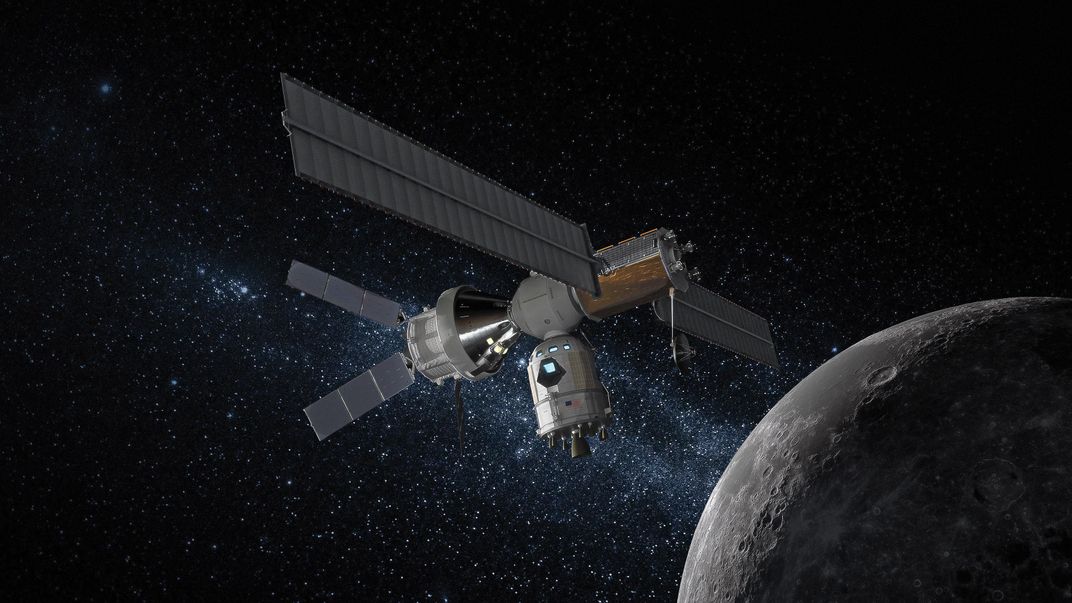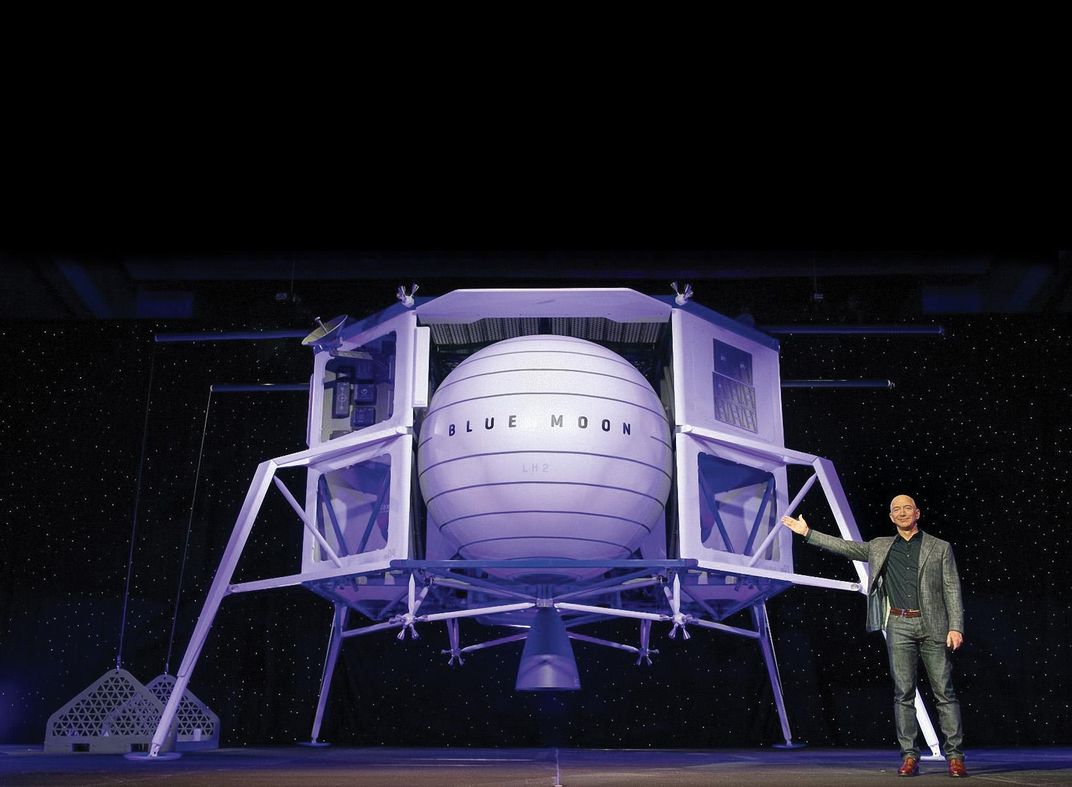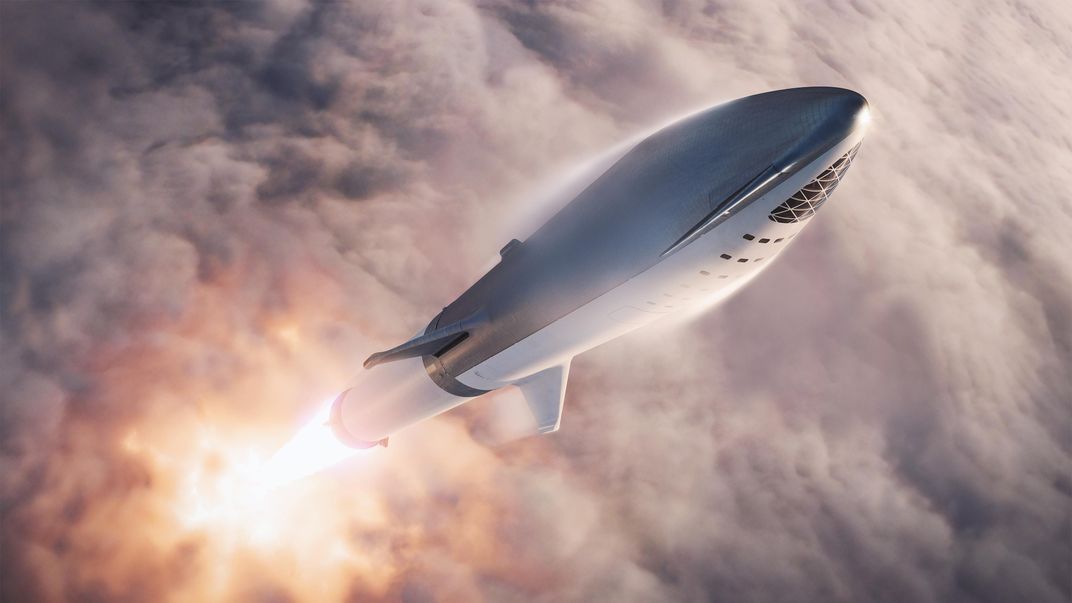To the Moon by 2024: Here’s the Plan
The first U.S. moonshot was done in a decade. Can NASA make it in half that time?
:focal(3280x666:3281x667)/https://tf-cmsv2-smithsonianmag-media.s3.amazonaws.com/filer/c5/8f/c58fb367-be05-4780-bc5a-9c0dbb16408c/02e_aug2019_hlsascending_live.jpg)
The vice president did his best to sound stirring. The podium, the flag, the ringing cadences—all were meant to convey that this moment in the spring of 2019 was a significant one, a turning point in the history of space exploration. “It is the stated policy of this administration and the United States of America to return American astronauts to the moon within the next...five...years.”
Hardly had Mike Pence concluded his March 26 speech to the National Space Council in Huntsville, Alabama, when the doubts and second-guessing began. Even at NASA headquarters, where Administrator Jim Bridenstine took questions from his troops at a televised town hall a few days later, the applause was tepid, and the questions had mostly to do with money and political commitment—and whether the plan will fall apart again, just as it always has.
There is a persistent belief among many in the space business that if another president would step forward and point NASA toward some grand goal, just as JFK did in 1961, the glory days would return. It hasn’t worked out that way. In 1989, on the 20th anniversary of the Apollo 11 landing, President George Bush senior unveiled his Space Exploration Initiative to send American astronauts to the moon, then on to Mars by 2019. Four years later the SEI was dead, canceled due to its price tag (half a trillion dollars) and lack of political support. In 2004, President George W. Bush introduced the Vision for Space Exploration. Same goals (starting with a moon landing in 2020), same result.
Why should it be different this time? That was the initial, skeptical reaction from most space pundits and the few politicians who paid Pence’s speech any notice. NASA had already been working toward a date of 2028 for the next human moon landing, and many considered even that ambitious, seeing that small robotic landers are still a year or more from launching. Now they were being asked to land people on the moon in just five years? Not gonna happen.
Then one company raised its hand as if to say, “Actually, we can do it.”
On its website, Lockheed Martin posted a short statement: “We fully support accelerating NASA’s goal of landing humans on the surface of the moon….With the right level of commitment, urgency and resources, humans could walk on the surface by 2024.”
It was an unusually bold claim for one of NASA’s contractors, who generally don’t like to overpromise. Unlike fellow aerospace giants Boeing and Northrop Grumman, Lockheed didn’t play a big part in Apollo. But the Colorado-based company has two major advantages for pulling off a near-term moon landing. It is the principal contractor for Orion, NASA’s first crew-rated deep space vehicle since Apollo, which has been in development for years and has already flown once, on a test flight in 2014. And Lockheed has experience in building planetary landers, going back to NASA’s Viking spacecraft of the 1970s.
Lockheed advanced planners had already been noodling around with designs for moon landers that could evolve to become Mars landers in the 2030s. And, says Rob Chambers, the company’s director of strategy for human space exploration, “We’re always looking at ways all of us can go faster.” So even before Pence’s speech, they were studying what they called an “accelerated lander”—a two-stage vehicle not all that different in principle from the Apollo Lunar Module. An ascent stage derived from Orion would sit atop a legged descent stage—which would also serve as a launch platform when the astronauts blast off from the moon and return to lunar orbit. The descent stage would likely use super-cold (cryogenic) propellants, probably hydrogen and oxygen. Apollo engineers had to make do with hydrazine, which is easier to store but has lower performance, which in turn forced them to build a heavier lander.
This is one area where engineering has advanced since the 1960s. “We have the technology today to have those propellants stay liquid for a week or two,” says Tim Cichan, Lockheed’s architect for space exploration. And that makes cryogenics, for the first time, an attractive option for the moon.
To make the 2024 deadline, Lockheed also suggested changes to the “Gateway,” a mini-space station in lunar orbit that’s central to NASA’s plans for moon exploration. Gateway will serve as a transportation depot: The lander will descend from there to the moon’s surface and return to Gateway when the astronauts are ready to come home. Cichan and his team would tweak NASA’s original concept by reducing the Gateway to as few elements as possible—a propulsion module, a docking port, and that’s about it.
Lockheed’s plan is not the only way to achieve a moon landing by 2024, but the company’s early thumbs-up signaled to doubters that such a schedule might in fact be possible. NASA quickly came to some of the same conclusions. To be ready in just five years, yes, the Gateway would have to be stripped down to basics. And the sequence of steps to the moon would have to be rethought.
The rejiggered mission sequence now looks like this: In 2020, NASA’s new Space Launch System (SLS) rocket will launch the Orion with no crew on board to orbit the moon and test the hardware. That’s Artemis 1. Two years later, the first element of the Gateway goes up, followed that same year or in 2023 by Artemis 2, which will send astronauts to the vicinity of the moon in an Orion spacecraft. Artemis 3 would follow in 2024 with the first human landing on the moon since 1972.
To have any hope of hitting those marks, the agency has had to shift into high gear. Bridenstine, the first NASA administrator born after Apollo, has been tireless in promoting the plan. NASA’s name for the program, Artemis, refers to the twin sister of Apollo, and Bridenstine has reemphasized that the next Americans on the moon will include at least one woman. “We need to create a movement for the Artemis Generation,” the administrator told an audience of students and educators in May.

The pace of drafting and awarding industry contracts—to conceptualize, design, and ultimately build the moon lander and other required hardware—is “actually pretty remarkable,” says Nantel Suzuki, NASA’s program executive for the human lunar lander system. Maxar Technologies of Colorado, formerly Space Systems Loral, was tapped to build the first element of the Gateway: its power and propulsion module. Prototype habitats for the mini-station designed by several companies are being evaluated on the ground. At the time of Pence’s announcement, NASA had already invited proposals to design the lunar lander’s descent module, but the agency hurriedly (by its standards) switched gears to issue a call this summer to design and build an entire landing vehicle, not just one piece.
Space agency managers may have to relax certain requirements to meet Pence’s target. They had wanted to send four astronauts on the first landing mission. Now they may have to settle for two. NASA wants to place the Gateway in a Near Rectilinear Halo Orbit, a complex, looping orbit that agency planners are convinced will pay off in terms of flexibility in reaching all parts of the lunar surface while satisfying other requirements of a long-term lunar exploration program. But they’re willing to entertain other approaches.
How long will the first landing crew stay on the lunar surface? Six and a half days is the current working number. Longer would be better. But if it ends up being just a week, so be it.
Bridenstine is sensitive to criticism that such a short stay could be perceived as a “flags and footprints” stunt—a much-maligned term among those, like him, who advocate permanent human expansion into the solar system. The administrator can hardly get through a speech these days without using the word “sustainable,” meaning that Artemis is seen as just the beginning of a lasting human presence on the moon.
But the skepticism hasn’t faded. The first Congressional hearings on the moon plan elicited very little excitement, with most members commenting along the lines of “We’ll reserve judgment until we see the detailed plan and budget.” And NASA managers have yet to adequately explain their hurry to reach the moon, other than to say they’re following White House orders.
You can’t say they aren’t trying, though.
Conventional wisdom holds that while the NASA of 50 years ago could work wonders, today’s space agency has lost its mojo and now suffers from what Pence in his March speech derided as “analysis paralysis.” There’s some truth to this criticism, at least politically and bureaucratically. Yet a moon landing in 2024 is doable, say Lockheed’s Chambers and others, precisely because it isn’t 1969 anymore. We know a lot more today than we did then.

Newcomers to human spaceflight—including SpaceX and Jeff Bezos’s Blue Origin—will be applying 21st-century technology and ideas to the problem of landing humans on the moon. In May, Bezos unveiled the company’s Blue Moon lander for delivering cargo or people to the surface beginning in the mid-2020s. SpaceX, which often reveals its plans only through Elon Musk’s tweets, is developing a Starship mega-rocket for deep space travel, and last year announced its intent to send Japanese billionaire Yusaku Maezawa and a hand-picked group of artists on a circumlunar voyage in 2023 (although little has been said about the project since). Will Starship be ready to land on the moon just a year later? SpaceX’s projects, impressive as they are, tend to suffer from schedule slip, like everyone else’s. Musk has said his company aims to land on the moon before heading out to Mars. His initial Twitter response to Pence’s speech made no promises about when or how: “It would be so inspiring for humanity to see humanity return to the moon!” was all he said.
NASA’s Suzuki sees one great benefit from the flurry of new contracts for commercial moon landers, both robotic and human. “We’re cultivating a new generation of engineers focused on the lunar landing problem,” he says.
Lockheed’s Chambers welcomes participation by any and all of them. To meet the 2024 goal, he says, “You’re going to need the will and the skill of everybody to pull this off.”
Doug Cooke, now an independent aerospace consultant, used to head NASA’s exploration office. He lived through the cancellation of the agency’s last moon/Mars program, after he helped set many of its key elements—including Orion—in motion. You’d think he would be jaded. But he surveys the technology at hand and concludes that a moon landing in 2024 “can be done.” The lunar surface has been mapped with very high precision, so navigation and hazard avoidance are easier propositions than they were in 1969. Spacecraft structures are well understood, and while cryogenic propulsion for lunar landers is a stretch, it’s a surmountable problem. The engineers have got this.

The biggest hurdle Cooke sees for NASA is streamlining its procurement process—to get things done quickly and spend the money efficiently. More funding will be required to hit 2024—NASA has already asked for an additional $1.6 billion next year and floated a figure of $30 billion for the total cost. But dollars alone won’t guarantee success. Lockheed’s Chambers agrees. “If you just threw enormous amounts of money at it and didn’t make decisions and didn’t get aluminum ordered this year and didn’t get people bending metal, all the money in the world wouldn’t do you any good.”
Of course, it could all fall apart again. In that case, American astronauts are unlikely to land on the moon in 2024—or perhaps ever. Science fiction writer Kim Stanley Robinson’s latest novel, Red Moon, is set 30 years in the future, when both the Chinese and Americans have bases on the moon. China’s lunar presence is larger, though, because it acted sooner and followed through. The United States, Robinson explains, “had already reached [the moon] in 1969 and was not prepared to return. Their billionaires returned to the moon before their state agencies, because the American government and people didn’t care.” Fifty years after Apollo, we’re about to find out whether they do or don’t.
